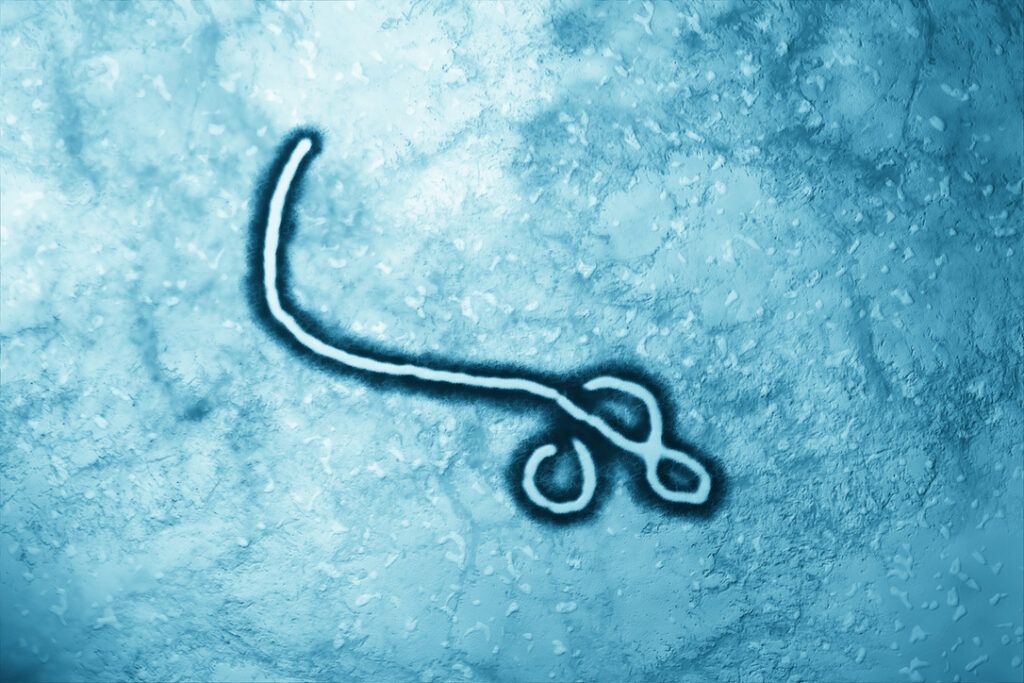What is Ebola?
The Ebola virus was first discovered in 1976 in the Democratic Republic of Congo near the Ebola river. It causes Ebola virus disease (EVD) in humans and nonhuman primates (monkeys, chimpanzees and gorillas) through direct contact with the virus, an infected person’s bodily fluids or their deceased body. So, you may catch it by touching the virus on items or being splashed by an infected person’s body fluids (blood, urine, feces, respiratory droplets, semen, and saliva) onto your mucous membranes or cuts in your skin. The mucous membranes include the mouth, nose and eyes. While the Ebola virus is highly contagious, you cannot catch the virus through the air.
EVD is caused by 5 different species of the virus. A sixth species, Bombali ebolavirus, is found in bats but does not cause disease. Four of the species cause disease in humans and other primates. They are named according to the region they were discovered. Those four are listed here:
- Zaire ebolavirus—the only one with a vaccine
- Sudan ebolavirus
- Tai Forest ebolavirus
- Bundibugyo ebolavirus
A fifth species, Reston ebolavirus, only infects nonhuman primates. It was discovered in Reston, Virginia, USA in 1989 in macaques.
The most common carrier and spreader of the ebolavirus is thought to be the African Fruit Bat. Depending on the outbreak, anywhere from 25-90% of persons infected will die. Consequently, the average death rate is 50%. For a breakdown of fatality rates per outbreak click here.
According to the World Health Organization, there have been over 34,000 known cases of ebola worldwide with over 15,000 deaths. Unfortunately, the actual number of cases is thought to be closer to 100,000.
What are the symptoms of the Ebola virus disease?
Symptoms are separated into DRY and WET symptoms. The incubation period, or time from exposure to infection, is 2-21 days.
“Dry” symptoms happen about 8-10 days after exposure to ebola:
- Fever-87%
- Malaise-76%
- Chills
- Body aches
“Wet” symptoms, or gastrointestinal symptoms, happen about 4-5 days after the dry symptoms:
- Nausea
- Vomiting-68%
- Abdominal pain
- Severe watery diarrhea-66%
Other possible symptoms of Ebola virus infection:
- Bruising
- Hiccups
- Rash—may happen on days 5-7
- Redness in eyes/conjunctival hemorrhage-this is not always present
- Frank hemorrhage/bleeding-18%
- Blood in stool-6%
- Loss of appetite-65%
- Miscarriage if pregnant
What is the treatment for Ebola virus infection?
- There are currently 2 monoclonal antibody treatments for Ebola that are FDA approved for adults and children in the U.S. Fortunately, both of these have proven effective during outbreaks.
- Many patients will need a large amount of fluid replacement due to diarrhea, vomiting and other complications of the infection.
- Blood pressure will need to be maintained as it often declines.
- Pain management is also critical in caring for the patient.
- A secondary infection will need to be treated in addition to possible septic shock.
- Organ failure and blood abnormalities will also need to be addressed.
Prevention
- Ervebo is a live vaccine that protects against one of the four ebolaviruses that infect humans, the Zaire ebolavirus. It is FDA approved in the U.S for adults 18 and over who are at risk of Ebola virus exposure. It has been available since 2019. Though it is a live vaccine it cannot cause ebola because it only has a portion of the virus and not the whole thing.
- Wash your hands often with soap and water. You may also use an alcohol-based hand sanitizer.
- Do not touch the body fluids of any infected or sick persons.
- Do not touch the body of someone who has died from the Ebola virus.
- Do not touch or handle any items that have come in contact with an infected person or their body fluids. This may include clothing, bedding, or medical equipment.
Conclusion
While ebola may be rare and most common in West Africa, it is deadly and does happen elsewhere. There have been a total of 4 cases in the U.S. Two of those cases were nurses infected by a person who traveled to the U.S. with ebola disease.
International travel and incubation periods of these bugs have opened borders to the once unthinkable. Remember, a new species of ebolavirus was discovered in animals in the USA.
So, it is prudent to continue researching and following these diseases to help prevent their spread. If you have any risk of exposure to ebolavirus protect yourself and get vaccinated.
Ebola 26 September 2022, Center for Disease Control and Prevention, cdc.gov, accessed 11/2022
Western Africa Ebola Virus Epidemic 27 October 2022, Ebola, en.Wikipedia.org, accessed 11/2022
Ebola virus disease 23 February 2021, Health topics, who.int., accessed 11/2022
Ebola facts 2022, Infectious Diseases Society of America, idsociety.org, accessed 11/2022
